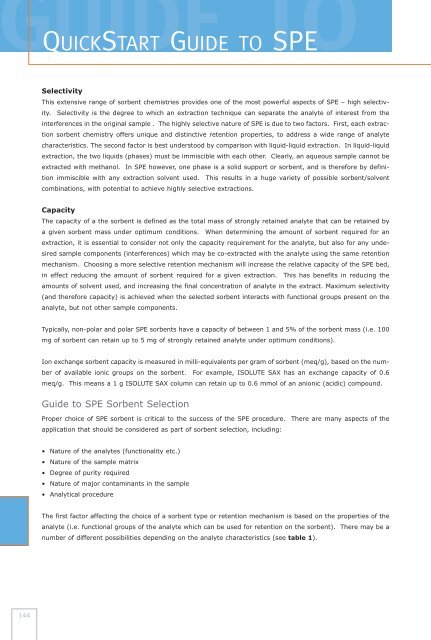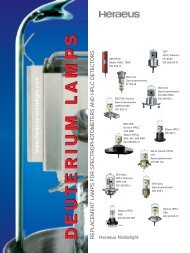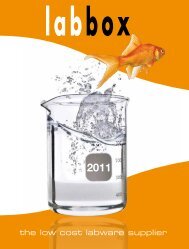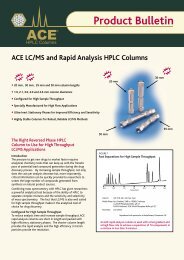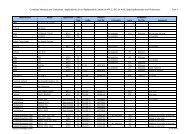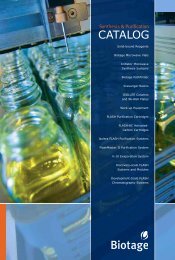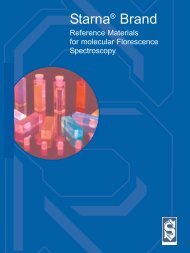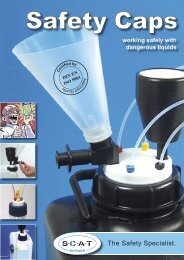PDF catalog - Teknolab AS
PDF catalog - Teknolab AS
PDF catalog - Teknolab AS
Create successful ePaper yourself
Turn your PDF publications into a flip-book with our unique Google optimized e-Paper software.
TO<br />
QUICKSTART GUIDE TO SPE<br />
Selectivity<br />
This extensive range of sorbent chemistries provides one of the most powerful aspects of SPE – high selectivity.<br />
Selectivity is the degree to which an extraction technique can separate the analyte of interest from the<br />
interferences in the original sample . The highly selective nature of SPE is due to two factors. First, each extraction<br />
sorbent chemistry offers unique and distinctive retention properties, to address a wide range of analyte<br />
characteristics. The second factor is best understood by comparison with liquid-liquid extraction. In liquid-liquid<br />
extraction, the two liquids (phases) must be immiscible with each other. Clearly, an aqueous sample cannot be<br />
extracted with methanol. In SPE however, one phase is a solid support or sorbent, and is therefore by definition<br />
immiscible with any extraction solvent used. This results in a huge variety of possible sorbent/solvent<br />
combinations, with potential to achieve highly selective extractions.<br />
Capacity<br />
The capacity of a the sorbent is defined as the total mass of strongly retained analyte that can be retained by<br />
a given sorbent mass under optimum conditions. When determining the amount of sorbent required for an<br />
extraction, it is essential to consider not only the capacity requirement for the analyte, but also for any undesired<br />
sample components (interferences) which may be co-extracted with the analyte using the same retention<br />
mechanism. Choosing a more selective retention mechanism will increase the relative capacity of the SPE bed,<br />
in effect reducing the amount of sorbent required for a given extraction. This has benefits in reducing the<br />
amounts of solvent used, and increasing the final concentration of analyte in the extract. Maximum selectivity<br />
(and therefore capacity) is achieved when the selected sorbent interacts with functional groups present on the<br />
analyte, but not other sample components.<br />
Typically, non-polar and polar SPE sorbents have a capacity of between 1 and 5% of the sorbent mass (i.e. 100<br />
mg of sorbent can retain up to 5 mg of strongly retained analyte under optimum conditions).<br />
Ion exchange sorbent capacity is measured in milli-equivalents per gram of sorbent (meq/g), based on the number<br />
of available ionic groups on the sorbent. For example, ISOLUTE SAX has an exchange capacity of 0.6<br />
meq/g. This means a 1 g ISOLUTE SAX column can retain up to 0.6 mmol of an anionic (acidic) compound.<br />
Guide to SPE Sorbent Selection<br />
Proper choice of SPE sorbent is critical to the success of the SPE procedure. There are many aspects of the<br />
application that should be considered as part of sorbent selection, including:<br />
• Nature of the analytes (functionality etc.)<br />
• Nature of the sample matrix<br />
• Degree of purity required<br />
• Nature of major contaminants in the sample<br />
• Analytical procedure<br />
The first factor affecting the choice of a sorbent type or retention mechanism is based on the properties of the<br />
analyte (i.e. functional groups of the analyte which can be used for retention on the sorbent). There may be a<br />
number of different possibilities depending on the analyte characteristics (see table 1).<br />
144


